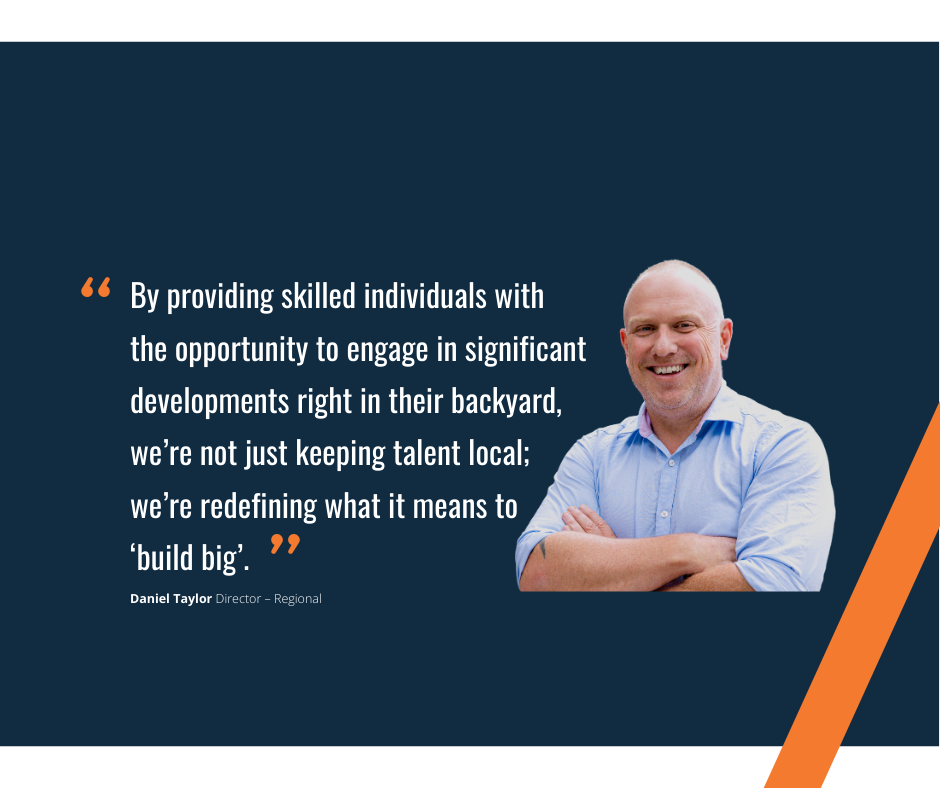
Australia’s regional and rural communities have long faced challenges stemming from the urban-rural divide, with limited access to services and opportunities commonly found in major cities.
However, a significant transformation is now underway, focusing on infrastructure development to close this gap and ignite economic growth in these crucial areas. This shift includes improvements in transportation networks, renewable energy projects, water infrastructure, and digital connectivity.
Daniel Taylor, Director - Regional, CaSE Civil & Structural Engineering, sheds light on the strategies and innovations driving the future of rural and regional Australia. Taylor emphasises that these infrastructure projects will significantly enhance the quality of life in these regions, unlocking new opportunities for communities that have often been overlooked.
This infrastructure-driven change marks the dawn of a new era for regional Australia, offering services and possibilities that were once exclusive to urban centres. The initiative represents a nationwide commitment to revitalising regional areas, ensuring that every community can thrive.
Enhancing transportation networks creates lifelines of connectivity
The expansion and improvement of transportation networks are pivotal to Australia's efforts to bridge the divide. Enhanced road, rail, and air connections are more than just conveniences; they are vital to integrating regional Australia into the national and global community. Infrastructure Australia’s 2023 Infrastructure Market Capacity report highlights the unprecedented level of investment flowing into regional areas, particularly in New South Wales, South Australia, and Queensland.
According to the report, some regions are set to see a 75% annual increase in infrastructure investment, with certain areas experiencing a doubling of investment within a year. This significant rise in construction activity speaks to the immense potential of infrastructure projects in shaping Australia's future. Renewable Energy Zones (REZs) like the New England REZ and transformative initiatives like the Inland Rail are designed to serve as economic catalysts, creating jobs and fostering economic growth in regional communities.
Underscoring the importance of these developments;
“These projects are not just about building; they represent a fundamental shift towards empowering our regional communities. We’re creating opportunities for skilled professionals to contribute to significant local projects, redefining what it means to ‘build big.’ This initiative challenges the traditional pull towards urban centres, fostering sustainable growth in regional areas.”
Daniel Taylor
By investing in transportation infrastructure, Australia is not only building more connected communities but also reinforcing its commitment to sustainable development. Improved connectivity will open doors for local businesses, agriculture, and tourism, allowing regional Australia to contribute more significantly to national economic resilience.
One of the most transformative aspects of regional development lies in enhancing digital connectivity. Broadband and mobile internet services act as gateways to essential services like education, healthcare, and business opportunities. The Australian Government’s Better Connectivity Plan, which allocates over $1.1 billion to improving telecommunications in rural and regional areas, reflects the transformative power of digital infrastructure.
Taylor highlights how critical digital connectivity is to modern infrastructure projects: “Digital connectivity enables advanced technologies like drones for land surveying and real-time data analytics for large-scale project oversight. Robust internet services are essential to integrating these innovations into daily operations, driving efficiency and smarter development in regional Australia.”
This connectivity is crucial to bridging the gap between urban and rural settings, making infrastructure development more inclusive and efficient. Enhanced digital access will empower regional communities to innovate, attract investment, and participate in the global economy.
Community involvement is key to ensuring that infrastructure projects meet the actual needs of regional Australia. Prime Minister Anthony Albanese, in his recent address at the Queensland Media Club, emphasised the importance of involving every community in shaping the nation’s future. For infrastructure development to be truly effective, local voices must be heard in the planning and decision-making processes.
Taylor echoes this sentiment, stressing that community engagement is essential for successful infrastructure projects. “It’s not just about consultation; it’s about collaboration. By involving local communities, creating jobs, and incorporating cultural heritage into our projects, we’re building more than infrastructure—we’re fostering stronger, more unified regions,” he says.
This collaborative approach ensures that infrastructure projects are not only physically transformative but also socially and culturally significant, enhancing community identity and cohesion.
While the future of regional Australia looks promising, workforce shortages present a major challenge. Infrastructure Australia’s 2023 report highlights the critical need for skilled labour, particularly in sectors crucial to infrastructure development. Shortages of engineers, tradespeople, and labourers pose risks to the timely and cost-effective delivery of these projects.
Taylor brings a fresh perspective to this issue, focusing on attracting professional talent to regional areas. “To ensure sustainable growth, regional Australia must appeal to professional couples,” he asserts, noting that creating job opportunities for diverse skill sets is crucial to retaining talent in these areas.
Addressing these workforce challenges will require a national infrastructure workforce strategy that focuses on education, training, and incentives to keep talent in regional Australia. By doing so, regional communities can continue to benefit from infrastructure investments and build resilience for the future.
Australia’s investment in infrastructure is laying the groundwork for a more connected and inclusive future. By focusing on transportation, renewable energy, digital connectivity, and water infrastructure, the country is working to narrow the urban-rural divide and create a more balanced, resilient nation. As these initiatives continue to unfold, they promise to transform regional areas into thriving communities, driving Australia toward a prosperous and united future.

Vanessa is an experienced marketing, business development, and strategy advisor with a passion for sharing the intricacies of civil and structural engineering ingenuity through a storytelling style that ignites engagement and fuels deeper learning.